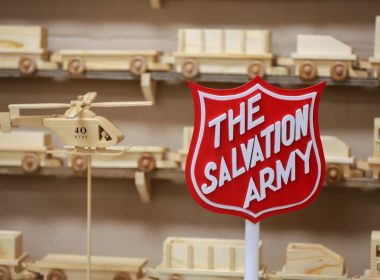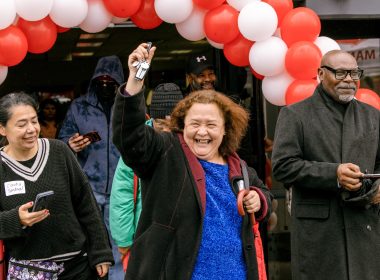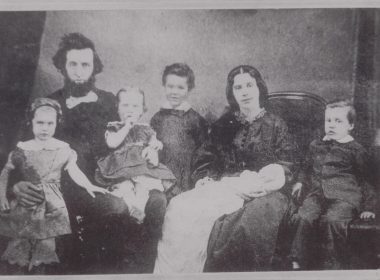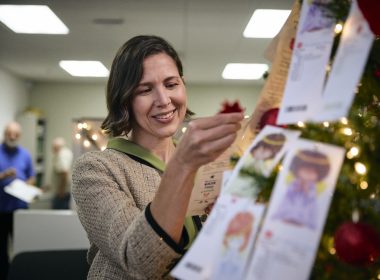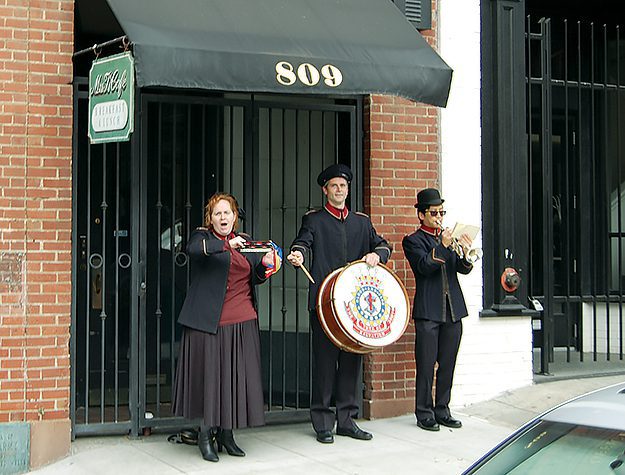 Attendees tour historical sites of the Army’s beginnings in the city
Attendees tour historical sites of the Army’s beginnings in the city
The Salvation Army hosted a Heritage Tour May 9 in San Francisco to celebrate its history in the Bay Area, dating back to 1883. Attendees traveled the city by cable car, visiting current and former Army locations, and experiencing historical reenactments of important past events.
 The tour stopped at Golden State Divisional Headquarters, Wells Boarding House, the site of the first salvation meeting, the original Chinatown Corps, the 1923 site of the Chinatown Corps, current Chinatown Corps, the Ray and Joan Kroc Corps Community Center, the former divisional and territorial headquarters, the former College for Officer Training, the Evangeline Residence, San Francisco Mission Corps, the Training College at Silver Avenue and the South of Market Corps.
The tour stopped at Golden State Divisional Headquarters, Wells Boarding House, the site of the first salvation meeting, the original Chinatown Corps, the 1923 site of the Chinatown Corps, current Chinatown Corps, the Ray and Joan Kroc Corps Community Center, the former divisional and territorial headquarters, the former College for Officer Training, the Evangeline Residence, San Francisco Mission Corps, the Training College at Silver Avenue and the South of Market Corps.
Golden State Divisional Headquarters
In 1989, just months before the Loma Prieta Earthquake, The Salvation Army moved its Northern California and Nevada Divisional Headquarters to a building on Folsom Street, which had faced foreclosure and never been finished. Colonels Bruce and Dorothy Harvey, divisional leaders at the time, determined that the new building would be a way to maintain a downtown profile for the Army.
 Original Chinatown Corps
Original Chinatown Corps
At 25 Turk Street, in a rough neighborhood where attitudes toward Chinese immigrants were hostile, The Salvation Army began work. In its first 10 years here, 67 officers were assigned to the Chinatown Corps, with an average appointment of five months. Almost all of the officers were of European heritage and many were single women officers assigned in pairs. The few officers of Chinese descent were actually Hawaiian who spoke the Hakka dialect and did not know Cantonese, the dominant language of the neighborhood. In spite of these language and cultural challenges, the ministry thrived with 1,329 Chinese attendees seeking salvation during the first 10 years.
 Ray and Joan Kroc Corps Community Center
Ray and Joan Kroc Corps Community Center
In the 1970s, The Salvation Army wanted to develop a halfway house in San Francisco’s Tenderloin neighborhood. It identified a building, which became the Bridgeway Residence. A 1915 map shows that the post-earthquake building was called Hotel Van Dorn, a few years before the Prohibition era.
In 1984, the Army made a decision to renovate the unused back of the building, which most likely had served as a speakeasy. Ironically, the narrow alleyway through which bootleggers may have walked became a waiting area with benches where homeless men could wait for the Eddy Street late-night shelter to open. The door that was open during Prohibition for people looking for a drink now welcomed men seeking shelter.
Today, this site houses the San Francisco Ray and Joan Kroc Corps Community Center.
 Former College for Officer Training
Former College for Officer Training
Originally built in 1937, the building on Laguna Street served as divisional headquarters for the Japanese Division in Northern California. The local Japanese community and the home country of Japan contributed large amounts of money to its construction, and the Emperor of Japan sent a personal gift.
The Japanese Division had eight corps under the leadership of Major Masasuke Kobayashi. In December 1941, during World War II, all Japanese-Americans were interned in war relocation camps, including Salvationists and officers. With the Japanese Division closed, the building became the College for Officer Training (CFOT).
Many years later, 16 murders and eight assaults occurred in what became known as the “zebra murders” in San Francisco. On April 1, 1974, Cadet Thomas Rainwater and Cadet Linda Story were shot by a man who had been following them after classes. Rainwater died and Story was seriously injured in the attack, but recovered.
The perpetrators of the attacks were caught and convicted, but the city was deeply shaken. Rainwater’s death was one of the deciding factors in moving CFOT from San Francisco to Southern California.
Evangeline Residence
In the 1920s, with the rise of the corporate office, a number of jobs opened up to women and supported many who had fled the poverty of the countryside.
In order for these women to have safe housing, organizations like The Salvation Army began providing boarding residences. The Salvation Army opened the Evangeline Residence in 1923 to meet this need, and sold the property in 1981 when the demand for this housing lowered.
 Original Training College – 801 Silver Avenue
Original Training College – 801 Silver Avenue
The new Training College was dedicated at 801 Silver Avenue in San Francisco in 1928. Built with then Territorial Commander Adam Gifford’s vision for growth in mind, the new facility had accommodations for 170 cadets.
Gifford set an ambitious goal of 200 cadets in the inaugural year of the Silver Avenue College, even though the previous three years had averaged 71 cadets per session. Just four months after the commissioning of the first session of cadets, the stock market crashed.
The Salvation Army had financed most of the construction of the Training College with bonds. Attempts to sell the Training College failed, so by the end of 1935 the strategy moved from selling to giving the property back to the bondholders. Finally, in 1938, the Army deeded the property over to a committee representing the bondholders. The Army booked a net loss of $380,693 on this transaction, which today would be about $6 million.

